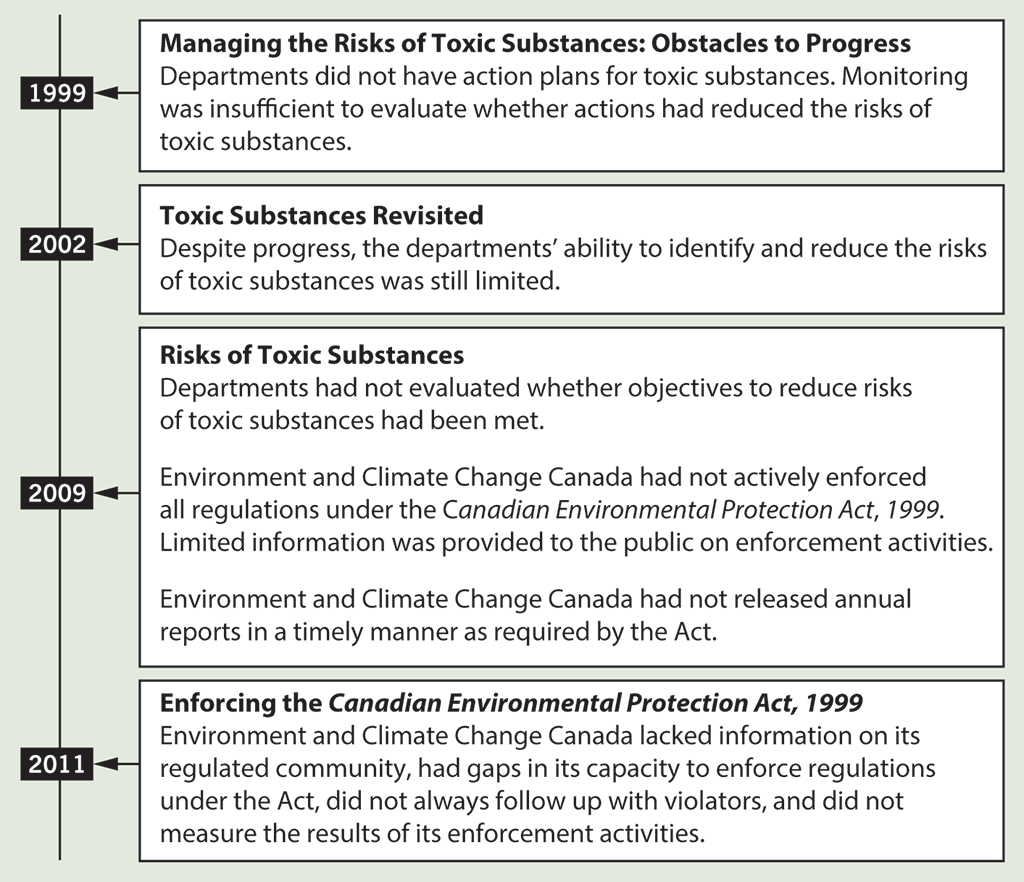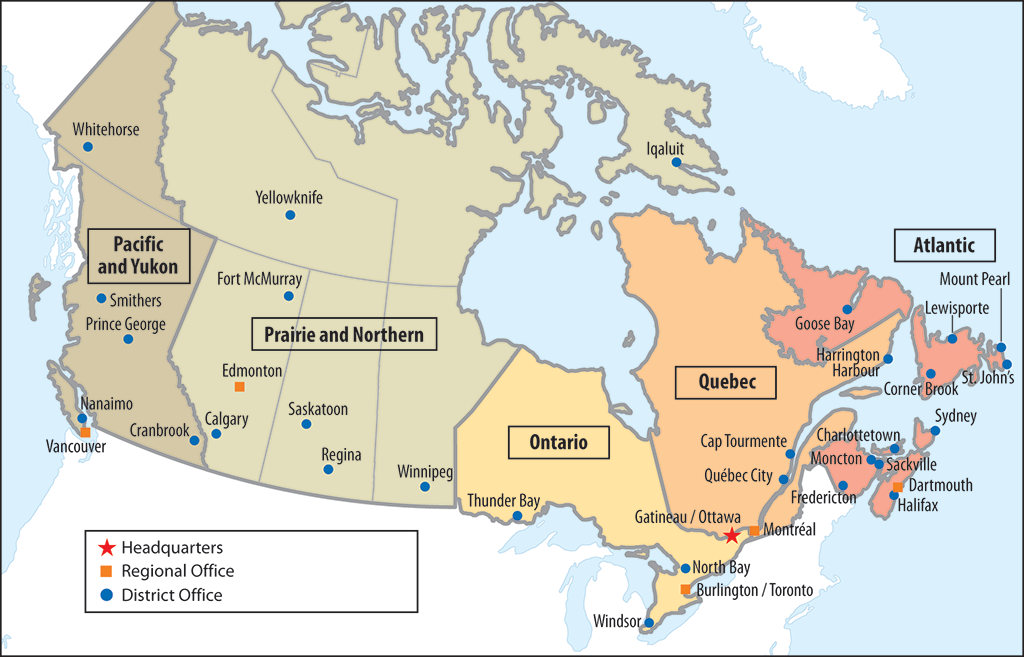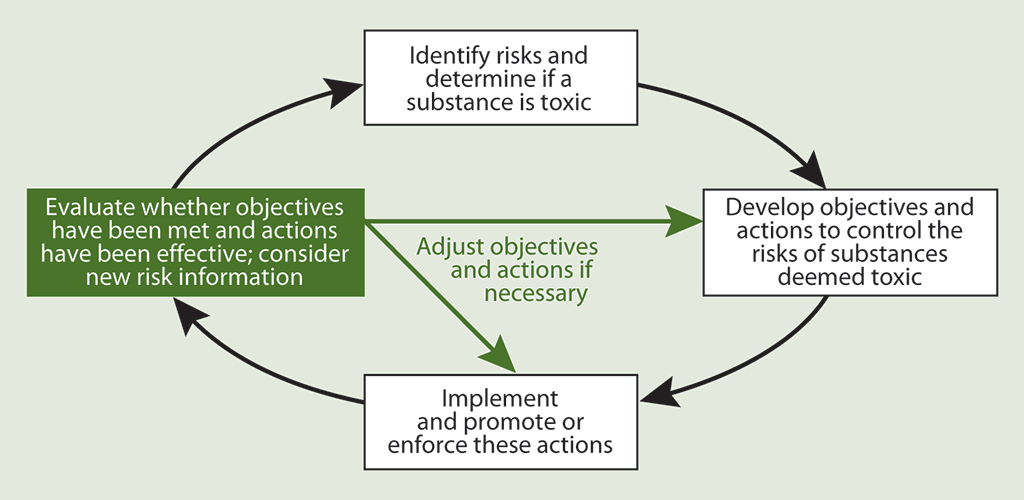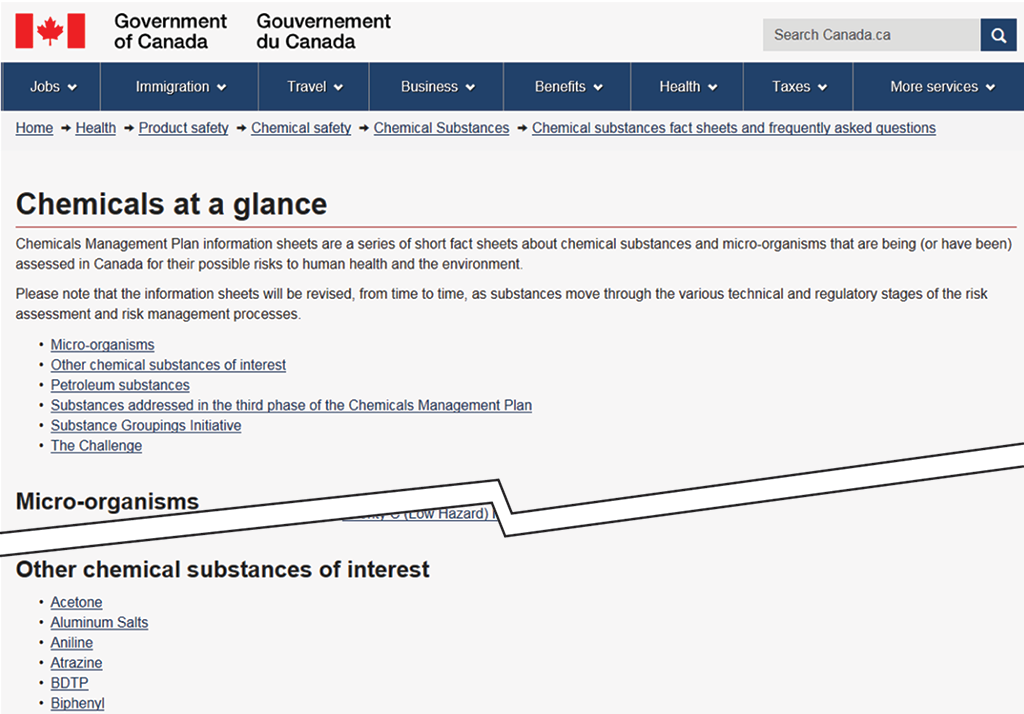
2018 Fall Reports of the Commissioner of the Environment and Sustainable Development to the Parliament of Canada Independent Auditor’s ReportReport 1—Toxic Substances
2018 Fall Reports of the Commissioner of the Environment and Sustainable Development to the Parliament of Canada Report 1—Toxic Substances
Independent Auditor’s Report
Table of Contents
- Introduction
- Findings, Recommendations, and Responses
- Conclusion
- About the Audit
- List of Recommendations
- Exhibits:
- 1.1—Our previous audits identified weaknesses in controlling toxic substances
- 1.2—Environment and Climate Change Canada has enforcement offices in five regions across the country
- 1.3—Enforcement activities were carried out under the Canadian Environmental Protection Act, 1999 during the 2014–15 to 2016–17 fiscal years
- 1.4—Environment and Climate Change Canada did little enforcement for most of the regulations to control toxic substances during the 2014–15 to 2016–17 fiscal years
- 1.5—Summary of risks, government objectives, and examples of regulations for five toxic substances
- 1.6—Evaluations help determine if departments are achieving their objectives in controlling toxic substances
- 1.7—Environment and Climate Change Canada and Health Canada moved slowly over the last eight years on our audit recommendation to evaluate progress
- 1.8—Environment and Climate Change Canada did not assess the effectiveness of its only code of practice for dichloromethane
- 1.9—Health Canada advised seniors and parents of young children about toxic hazards in the home
- 1.10—Website on chemical substances was not easy for the public to understand or navigate
Introduction
Background
1.1 Canadians use many goods and services that can release toxic substances. Exposure to these substances from computers, fabrics, fuels, dry cleaning, and other goods and services may lead to a variety of serious health issues—including cancer, autoimmune diseases, and nerve disorders. These substances can also affect wildlife and the quality of Canada’s air, soil, and water.
1.2 The Canadian Environmental Protection Act, 1999 requires the Government of Canada to control and prevent the risks of toxic substances. Under the Act, a substance is considered toxic if it can enter the environment in a way that endangers the environment or human health, or both. As of December 2017, there were 138 substances considered toxic under the Act.
1.3 Both Environment and Climate Change Canada and Health Canada have responsibilities for controlling and reducing toxic substance release and exposure. The departments’ responsibilities include
- developing control actions, such as regulations;
- evaluating progress to reduce the risks of toxic substances;
- increasing awareness, understanding, and compliance with the Act’s requirements; and
- communicating information to the public about the effects of toxic substances on human health and the environment.
1.4 Environment and Climate Change Canada is also responsible for enforcing 39 regulations to control certain toxic substances under the Act. The Department’s enforcement involves
- inspecting sites and reviewing businesses’ reports to verify compliance with the Act and its regulations;
- investigating alleged instances of non-compliance; and
- issuing enforcement measures if violations are found, including warnings, directions, tickets, and environmental protection compliance orders.
1.5 The federal government allocated $1.13 billion during the 2005–06 to 2017–18 fiscal years to help implement the Chemicals Management Plan. This plan, established in 2006, is part of the government’s strategy to reduce the risks of toxic substance release and exposure.
1.6 Given the importance of controlling toxic substances, the Commissioner of the Environment and Sustainable Development has audited this topic several times since 1999 (Exhibit 1.1).
Exhibit 1.1—Our previous audits identified weaknesses in controlling toxic substances

Exhibit 1.1—text version
This timeline lists the titles and main findings of the Commissioner of the Environment and Sustainable Development’s audits related to toxic substances from 1999 to 2011.
| Year | Audit title | Main findings |
|---|---|---|
|
1999 |
Managing the Risks of Toxic Substances: Obstacles to Progress |
Departments did not have action plans for toxic substances. Monitoring was insufficient to evaluate whether actions had reduced the risks of toxic substances. |
|
2002 |
Toxic Substances Revisited |
Despite progress, the departments’ ability to identify and reduce the risks of toxic substances was still limited. |
|
2009 |
Risks of Toxic Substances |
Departments had not evaluated whether objectives to reduce risks of toxic substances had been met. Environment and Climate Change Canada had not actively enforced all regulations under the Canadian Environmental Protection Act, 1999. Limited information was provided to the public on enforcement activities. Environment and Climate Change Canada had not released annual reports in a timely manner as required by the Act. |
|
2011 |
Enforcing the Canadian Environmental Protection Act, 1999 |
Environment and Climate Change Canada lacked information on its regulated community, had gaps in its capacity to enforce regulations under the Act, did not always follow up with violators, and did not measure the results of its enforcement activities. |
1.7 In our 2009 audit, we found that although Environment and Climate Change Canada and Health Canada had action plans for most of the toxic substances we examined, concerns remained. We found that the federal government had not evaluated whether it met objectives to reduce the risks from toxic substances.
1.8 In our 2011 audit, we found that Environment and Climate Change Canada did not adequately enforce compliance with the Canadian Environmental Protection Act, 1999 to minimize threats to Canadians and their environment from pollution.
1.9 The Commissioner of the Environment and Sustainable Development also completed a related audit in 2016 on chemicals in consumer products and cosmetics.
Focus of the audit
1.10 This audit focused on whether Environment and Climate Change Canada enforced regulations under the Canadian Environmental Protection Act, 1999 to control the risks of toxic substances. We examined six toxic substances to determine whether Environment and Climate Change Canada and Health Canada had evaluated their progress in meeting objectives for reducing risks to the environment and human health. We also examined whether the departments communicated the risks of toxic substances to the public.
1.11 This audit is important because Canadians depend on the federal government to reduce the risks of toxic substances to human health and the environment, and to communicate these risks.
1.12 We did not examine the assessment of chemicals to determine whether substances were considered toxic under the Canadian Environmental Protection Act, 1999.
1.13 More details about the audit objective, scope, approach, and criteria are in About the Audit at the end of this report.
Findings, Recommendations, and Responses
Overall message
1.14 Overall, we found that despite long-standing efforts, Environment and Climate Change Canada and Health Canada still had significant work to do in selected areas to effectively control the risks of toxic substances and to inform Canadians about those risks.
1.15 Environment and Climate Change Canada had improvements to make in some aspects of its approach to enforcing toxic substance regulations under the Canadian Environmental Protection Act, 1999. The department conducted inspections and other enforcement activities to ensure that businesses complied with regulations on toxic substances, but in most cases, it did not base its enforcement priorities on risks to human health and the environment. For example, some 2,200 of the more than 10,000 inspections the Department carried out during the 2014–15 to 2016–17 fiscal years targeted a single toxic substance used by dry cleaners. However, there was no documented evidence that this substance presented a higher risk to human health or the environment than other substances.
1.16 In addition, Environment and Climate Change Canada had not fully addressed selected recommendations from our previous audits. The Department lacked timely access to information about which businesses were regulated, had not yet set time frames to follow up on violations, and had not addressed all of the enforceability issues it had identified in regulations.
1.17 Furthermore, Environment and Climate Change Canada and Health Canada had not completed work to address our 2009 recommendation to assess whether they were meeting their overall objectives to reduce the risks of toxic substances to human health and the environment.
1.18 Both Health Canada and Environment and Climate Change Canada play a role in informing the public about health and environmental risks from toxic substances. We found that information on Health Canada’s website was often unclear and difficult to find.
1.19 For example, visitors to Health Canada’s home page had to click through several web pages for information about toxic substances and then navigate to a different Government of Canada website to access “Chemicals at a glance.” Environment and Climate Change Canada’s communication activities to explain environmental risks were limited. These weaknesses made it difficult for Canadians to find information to make informed choices about toxic substances.
Enforcing regulations
1.20 Businesses that use, manufacture, sell, and dispose of toxic substances, such as those in consumer and industrial products, may be subject to regulations under the Canadian Environmental Protection Act, 1999 that require them to
- limit the quantity of toxic substances released into the environment,
- restrict where toxic substances may be released,
- adhere to certain manufacturing or commercial processes,
- regulate imports and sales, and
- report toxic substance releases to the federal government.
1.21 Regulations under the Act can apply to one or more toxic substances. For example, the Products Containing Mercury Regulations apply only to mercury, while the Prohibition of Certain Toxic Substances Regulations, 2012 apply to 26 toxic substances. While some regulations have been in force in Canada for decades, regulations can also respond to emerging issues. An example is the Microbeads in Toiletries Regulations, which came into force in January 2018.
1.22 During our audit, Environment and Climate Change Canada had 201 enforcement officer positions in five regions across the country (Exhibit 1.2). These officers enforced regulations under the Canadian Environmental Protection Act, 1999 and provisions of the Fisheries Act.
Exhibit 1.2—Environment and Climate Change Canada has enforcement offices in five regions across the country

Note: Not all district offices shown on this map are responsible for enforcing the Canadian Environmental Protection Act, 1999.
Source: Based on information provided by Environment and Climate Change Canada
Exhibit 1.2—text version
This map shows where Environment and Climate Change Canada’s enforcement offices are located in five regions across Canada. The Department’s enforcement headquarters are located in Gatineau, Quebec, and Ottawa, Ontario. Each of the five regions has a regional office and several district offices.
In the Pacific and Yukon region, the regional office is in Vancouver, British Columbia, and district offices are in
- Whitehorse, Yukon;
- Smithers, British Columbia;
- Prince George, British Columbia;
- Nanaimo, British Columbia; and
- Cranbrook, British Columbia.
In the Prairie and Northern region, the regional office is in Edmonton, Alberta, and district offices are in
- Iqaluit, Nunavut;
- Yellowknife, Northwest Territories;
- Fort McMurray, Alberta;
- Calgary, Alberta;
- Saskatoon, Saskatchewan;
- Regina, Saskatchewan; and
- Winnipeg, Manitoba.
In the Ontario region, the regional office has staff in Burlington, Ontario, and Toronto, Ontario, and district offices are in
- Thunder Bay, Ontario;
- North Bay, Ontario; and
- Windsor, Ontario.
In the Quebec region, the regional office is in Montréal, Quebec, and district offices are in
- Harrington Harbour, Quebec;
- Cap Tourmente, Quebec; and
- Québec City, Quebec.
In the Atlantic region, the regional office is in Dartmouth, Nova Scotia, and district offices are in
- Goose Bay, Newfoundland and Labrador;
- Lewisporte, Newfoundland and Labrador;
- Mount Pearl, Newfoundland and Labrador;
- St. John’s, Newfoundland and Labrador;
- Corner Brook, Newfoundland and Labrador;
- Charlottetown, Prince Edward Island;
- Moncton, New Brunswick;
- Sackville, New Brunswick;
- Fredericton, New Brunswick;
- Sydney, Nova Scotia; and
- Halifax, Nova Scotia.
Note: Not all district offices shown on this map are responsible for enforcing the Canadian Environmental Protection Act, 1999.
Source: Based on information provided by Environment and Climate Change Canada
Environment and Climate Change Canada did not base most of its enforcement priorities on risks to human health and the environment
1.23 Environment and Climate Change Canada conducted inspections and other enforcement activities. Although the Department focused on businesses with the potential for non-compliance, we found that it did not base most of its enforcement priorities on risks to human health and the environment.
1.24 Our analysis supporting this finding presents what we examined and discusses the following topics:
1.25 This finding matters because enforcement activities help ensure that businesses comply with regulations to protect the environment and human health from toxic substances.
1.26 Our recommendation in this area of examination appears at paragraph 1.38.
1.27 What we examined. We examined whether Environment and Climate Change Canada enforced regulations under the Canadian Environmental Protection Act, 1999 to control the risks of toxic substances.
1.28 Enforcement activities. Environment and Climate Change Canada undertook various types of enforcement activities to regulate toxic substances. Exhibit 1.3 lists enforcement activities and court actions carried out under the Canadian Environmental Protection Act, 1999 during the 2014–15 to 2016–17 fiscal years.
Exhibit 1.3—Enforcement activities were carried out under the Canadian Environmental Protection Act, 1999 during the 2014–15 to 2016–17 fiscal years
| Enforcement actions | Description | Number of actions |
|---|---|---|
| Inspections | Inspections include site visits or reviews of business reports submitted. | 10,180 |
| Enforcement measures if a violation is found | ||
| Tickets | Tickets are issued to businesses for offences with minimal or no threat to the environment or to human life or health. | 95 |
| Written warnings | Written warnings are formal written notices to inform businesses of minor violations and request corrective action. | 4,285 |
| Written directions | Written directions are official instructions obliging businesses to take all reasonable actions to remedy dangerous conditions or reduce environmental dangers. | 6 |
| Injunctions | The Minister has the authority to seek an injunction in order to stop or prevent a violation of the Act. | 0 |
| Ministerial orders | Ministerial orders require businesses to take prompt and immediate action to prevent unlawful manufacture, importation, distribution, or sale of toxic substances, or to recall products from the marketplace. | 0 |
| Environmental protection compliance orders | Environmental protection compliance orders direct violators to comply with the Act and its associated regulations. | 603 |
| Environmental protection alternative measures | Environmental protection alternative measures allow businesses to negotiate corrective action without court trials. Examples include cleanup, monitoring, and production changes. | 9 |
| Court actions resulting from enforcement activities | ||
| Prosecutions | Prosecution is a legal proceeding to determine whether or not the accused is guilty of committing an offence under the Act. | 48 |
| Convictions | The number of convictions is the number of businesses found guilty or that pleaded guilty as a result of prosecutions. | 34 |
Source: Based on information provided by Environment and Climate Change Canada
1.29 Enforcement priorities. Environment and Climate Change Canada had an annual process, with input from regions and headquarters, to identify enforcement priorities. According to the Department, key areas for enforcement were selected on the basis of factors such as environmental and human health risk, compliance issues, and operational capacity.
1.30 For example, for the 2015–16 fiscal year, the Department selected regulations related to vehicles and engines, for which non-compliance could lead to smog and acid rain. For the same fiscal year, the Department selected the PCB Regulations to verify whether businesses had destroyed equipment containing polychlorinated biphenyls (PCBs) as required. Such equipment posed an increased risk of soil and groundwater contamination.
1.31 However, we found overall that risk to the environment and human health was not a key criterion in prioritizing most of Environment and Climate Change Canada’s enforcement activities. According to the Department, it prioritized enforcement activities mainly on the basis of businesses’ potential for non-compliance. Consequently, the Department did not know whether its targeted enforcement activities focused on businesses that posed the greatest risks to human health and the environment.
1.32 We found that most toxic substance regulations received few inspections and enforcement measures (Exhibit 1.4). The Department carried out 10,180 inspections in the 2014–15 to 2016–17 fiscal years. Of these, 2,231 (about 22%) focused on tetrachloroethylene, a single toxic substance used by dry cleaners. No documentation indicated that this substance, a toxic air pollutant, posed a higher risk to human health and the environment than other substances.
Exhibit 1.4—Environment and Climate Change Canada did little enforcement for most of the regulations to control toxic substances during the 2014–15 to 2016–17 fiscal years

Note: The Microbeads in Toiletries Regulations were not in force until 2018 and are not included in the above analysis.
Source: Based on information provided by Environment and Climate Change Canada
Exhibit 1.4—text version
This exhibit consists of two parts: a bar chart and a list.
The bar chart shows the toxic substance regulations with the most reported inspections and enforcement measures from 1 April 2014 to 30 March 2017. For each of these regulations, the inspections and enforcement measures are listed separately as percentages of the total inspections and enforcement measures reported for this time period.
| Title of regulation | Percentage of total reported inspections | Percentage of total reported enforcement measures |
|---|---|---|
| Tetrachloroethylene (Use in Dry Cleaning and Reporting Requirements) Regulations | 21.9% | 27.8% |
| PCB Regulations | 19.9% | 15.3% |
| Export and Import of Hazardous Waste and Hazardous Recyclable Material Regulations | 11.4% | 5.4% |
| Federal Halocarbon Regulations, 2003 | 10.2% | 5.1% |
| Environmental Emergency Regulations | 9.4% | 27.5% |
| Gasoline and Gasoline Blend Dispensing Flow Rate Regulations | 6.2% | 2.2% |
| Benzene in Gasoline Regulations | 4.0% | 0.0% |
| Sulphur in Diesel Fuel Regulations | 3.9% | 0.3% |
| Disposal at Sea Regulations | 2.9% | 0.2% |
| Chromium Electroplating, Chromium Anodizing and Reverse Etching Regulations | 2.1% | 3.3% |
| Off-Road Compression-Ignition Engine Emission Regulations | 1.1% | 5.4% |
| Off-Road Small Spark-Ignition Engine Emission Regulations | 1.1% | 2.8% |
| Marine Spark-Ignition Engine, Vessel and Off-Road Recreational Vehicle Emission Regulations | 0.7% | 1.7% |
| Renewable Fuels Regulations | 0.4% | 1.5% |
| On-Road Vehicle and Engine Emission Regulations | 0.2% | 1.0% |
The exhibit also lists the other toxic substance regulations in force from 1 April 2014 to 30 March 2017, each of which accounted for less than 1% of all reported inspections and less than 1% of all reported enforcement measures:
- 2-Butoxyethanol Regulations
- Asbestos Mines and Mills Release Regulations
- Chlor-Alkali Mercury Release Regulations
- Contaminated Fuel Regulations
- Export of Substances on the Export Control List Regulations
- Gasoline Regulations
- Heavy-duty Vehicle and Engine Greenhouse Gas Emission Regulations
- Interprovincial Movement of Hazardous Waste Regulations
- Multi-Sector Air Pollutants Regulations
- Ozone-depleting Substances and Halocarbon Alternatives Regulations
- Passenger Automobile and Light Truck Greenhouse Gas Emission Regulations
- PCB Waste Export Regulations, 1996
- Products Containing Mercury Regulations
- Prohibition of Certain Toxic Substances Regulations, 2012
- Pulp and Paper Mill Defoamer and Wood Chip Regulations
- Pulp and Paper Mill Effluent Chlorinated Dioxins and Furans Regulations
- Reduction of Carbon Dioxide Emissions From Coal-fired Generation of Electricity Regulations
- Secondary Lead Smelter Release Regulations
- Solvent Degreasing Regulations
- Sulphur in Gasoline Regulations
- Tributyltetradecylphosphonium Chloride Regulations
- Volatile Organic Compound (VOC) Concentration Limits for Architectural Coatings Regulations
- Volatile Organic Compound (VOC) Concentration Limits for Automotive Refinishing Products Regulations
Note: The Microbeads in Toiletries Regulations were not in force until 2018 and are not included in the above analysis.
Source: Based on information provided by Environment and Climate Change Canada
1.33 Department officials told us that Environment and Climate Change Canada prioritized tetrachloroethylene to respond to our 2011 audit recommendation to calculate compliance rates. Although the focus on this substance did result in higher compliance rates, given the seven years since our 2011 audit, we would have expected other substances to have been selected as priorities for enforcement, based on risk.
1.34 We found that the Department carried out fewer inspections for other regulations as compared with the tetrachloroethylene regulation. For example, a regulation prohibiting 26 toxic substances from being manufactured, used, sold, or imported in Canada (the Prohibition of Certain Toxic Substances Regulations, 2012) had no inspections.
1.35 Court actions. We found that there were more prosecutions under the Canadian Environmental Protection Act, 1999 than in our previous audit, with most court actions related to the dry cleaning regulation.
1.36 In the 2010–11 fiscal year, there were 2 prosecutions and no convictions for all regulations. In the 2016–17 fiscal year, there were 21 prosecutions and 9 convictions for regulations related to toxic substances. During the 2014–15 to 2016–17 fiscal years, nearly 70% of convictions were related to the dry cleaning regulation.
1.37 Furthermore, we found that according to Environment and Climate Change Canada, the amounts of fines collected under the Act had increased. For example, in the 2016–17 fiscal year, convictions under the PCB Regulations led to $1.74 million in fines from two regulated businesses—the largest fines that had ever been imposed under the Act.
1.38 Recommendation. Environment and Climate Change Canada should ensure that risks to human health and the environment are taken into account when prioritizing its enforcement activities.
Environment and Climate Change Canada’s response. Agreed. Environment and Climate Change Canada’s enforcement mandate is, first and foremost, to restore or establish compliance with all of the Department’s laws and regulations. However, the Department agrees that there would be benefits in better articulating how environmental and human health concerns are taken into account when it sets enforcement priorities.
To that end, the Department will develop a risk framework that assesses the risks associated with potential non-compliance with regulatory requirements for substances managed under the Chemicals Management Plan. The Department will also develop an overarching policy approach that articulates how environmental and human health risks are taken into account in setting inspection priorities.
Environment and Climate Change Canada had not fully addressed selected recommendations found in our previous audits
1.39 We found that since our 2009 and 2011 audits, Environment and Climate Change Canada had not made satisfactory progress on selected recommendations related to enforcement.
1.40 Our analysis supporting this finding presents what we examined and discusses the following topics:
- Action on enforceability issues identified in regulations
- Timely information about which businesses were regulated
- Time frames for following up on non-compliance
- Key intelligence information
- Reporting of results
1.41 This finding matters because enforcing the Canadian Environmental Protection Act, 1999 is important to protecting the health of Canadians, biodiversity, and the quality of Canada’s air, soil, and water.
1.42 Our recommendations in this area of examination appear at paragraphs 1.46, 1.50, 1.53, and 1.59.
1.43 What we examined. We examined whether Environment and Climate Change Canada addressed selected recommendations from our 2009 and 2011 audits regarding enforcement of the Canadian Environmental Protection Act, 1999.
1.44 Action on enforceability issues identified in regulations. In 2010, Environment and Climate Change Canada identified enforceability issues in 22 regulations related to toxic substances. These issues affected enforcement and included vague language, undefined key terms, and problematic laboratory testing methods.
1.45 We found that although the Department had acted on some of the enforceability issues it identified, for 17 regulations it had not yet proposed all required regulatory amendments, where appropriate, or non-regulatory approaches. For example, the Department noted that under the Solvent Degreasing Regulations, designed to limit the amounts of two toxic substances that businesses could use, it was unclear at what point a business would be considered in violation. At the time of the audit, the Department was examining options to address the remaining enforceability issues that it had identified.
1.46 Recommendation. Environment and Climate Change Canada should address the remaining enforceability issues it has identified in regulations under the Canadian Environmental Protection Act, 1999. These include proposing regulatory and non-regulatory approaches to better support enforcement. Regulatory approaches could include more specific regulatory language and appropriate laboratory testing methods.
Environment and Climate Change Canada’s response. Agreed. In 2011, in response to the Commissioner of the Environment and Sustainable Development’s audit on enforcing the Canadian Environmental Protection Act, 1999, Environment and Climate Change Canada agreed to develop action plans to address regulatory gaps in record keeping, test methods, and incidental presence.
This resulted in a review of the regulations under the Act and the identification of problematic areas. Regulatory amendments are under way to address some of the problematic areas that were identified. In some instances where regulatory amendments were not needed to address the issue, the Department adopted other approaches to enable enforcement. The Department will finalize the work currently under way to address the remaining enforceability issues that were identified in the regulations.
1.47 Timely information about which businesses were regulated. In our 2011 audit, we found that Environment and Climate Change Canada was uncertain about which businesses were regulated. In this audit, we found that some enforcement officers lacked timely access to key information to help them identify the businesses subject to regulation.
1.48 For example, enforcement officers did not have a complete list of all buildings that had equipment containing polychlorinated biphenyls (PCBs), which are toxic substances that have the potential to cause cancer. In some cases, information on which businesses were regulated was located in databases of other branches in the Department. Enforcement officers stated that they had to complete time-consuming requests to obtain this information.
1.49 We noted that in 2016, the Department developed a tool to help identify businesses under new or amended regulations. But during our audit period, this tool was applied to only two regulations.
1.50 Recommendation. Environment and Climate Change Canada should provide enforcement officers with comprehensive and up-to-date information to target regulated businesses under the Canadian Environmental Protection Act, 1999.
Environment and Climate Change Canada’s response. Agreed. Since the Commissioner of the Environment and Sustainable Development’s 2011 audit on enforcing the Canadian Environmental Protection Act, 1999, Environment and Climate Change Canada has made significant efforts to obtain more comprehensive information about the regulated community. In particular, since 2016, an implementation strategy has been developed for every new or amended regulation. The implementation strategy includes detailed information about the regulated community, including the types of sectors regulated, the number of businesses in each sector, and the number of businesses by geographic region.
Environment and Climate Change Canada will continue to develop implementation strategies for every new or amended regulation under the Canadian Environmental Protection Act, 1999.
For regulations that came into force before 2016, the Department will use a risk-based approach to identify those for which more information is needed about the regulated community, and will identify a plan of action to address the information gaps.
The Department will also review existing practices for making information about businesses available to enforcement officers.
1.51 Time frames for following up on non-compliance. Despite a recommendation in our previous audit, we found that Environment and Climate Change Canada still had not established standard time frames, based on risk, for follow-up after a violation.
1.52 The Department implemented a new enforcement information system in 2017. We were unable to determine whether Environment and Climate Change Canada followed up with non-compliant businesses. We could not determine when follow-up inspections were carried out, or how long they took, as such data was not searchable in the system.
1.53 Recommendation. Environment and Climate Change Canada should establish a standard time frame for following up with violators, based on risk, to verify compliance and monitor whether follow-up has been done.
Environment and Climate Change Canada’s response. Agreed. Environment and Climate Change Canada will develop a risk-based performance protocol for following up with violators, where warranted, to verify whether they have returned to compliance.
1.54 Key intelligence information. To support enforcement operations, Environment and Climate Change Canada employed 16 intelligence officials responsible for collecting and analyzing intelligence information to help the Department make strategic decisions on which regulations to prioritize. We found that the Department had challenges in fulfilling intelligence needs to assist enforcement officers in making informed decisions.
1.55 We found that some regions had no dedicated intelligence staff, or had only one full-time staff member responsible for an entire region. For example, according to the Department, Ontario had the largest number of regulated businesses, but no permanent intelligence staff.
1.56 Key intelligence information is important to targeting the work of enforcement officers. We noted that the Department had completed a strategic intelligence assessment on engines and vehicle emissions (related to 6 out of 39 toxic substance regulations) to identify businesses with high non-compliance.
1.57 Reporting of results. The Canadian Environmental Protection Act, 1999 requires the Minister of Environment and Climate Change to report on the Act’s enforcement “as soon as possible” after each fiscal year-end. In its response to our previous audit, the Department committed to publishing these reports, including information on results achieved, each fall—that is, about 6 to 8 months after the fiscal year-end.
1.58 We found that although timelines had improved, the report for the 2014–15 fiscal year was published more than 10 months after the end of the fiscal year. The 2016–17 report was delayed more than a year after the fiscal year-end. Without timely information, the public and parliamentarians do not have useful, up-to-date information on the Department’s enforcement of the Act and progress in reducing risks of toxic substances.
1.59 Recommendation. Environment and Climate Change Canada should define when it will complete Canadian Environmental Protection Act, 1999 annual reports to ensure they are released as soon as possible after the end of each fiscal year, as required in the Act. These reports should include information on departmental progress to reduce or eliminate risks of toxic substances.
Environment and Climate Change Canada’s response. Agreed. Section 342 of the Canadian Environmental Protection Act, 1999 requires the Minister to table a report on the administration and enforcement of the Act as soon as possible after the end of each fiscal year. The report must include research conducted under the authority of the Act. Typically, the reports cover actions and accomplishments within the scope of the Act, including research, enforcement, administration of the Act, and progress on a wide range of environmental protection issues.
Most of these activities are also reported in the Canadian Environmental Protection Act, 1999 Environmental Registry, which is maintained daily as required. Furthermore, the department maintains the Environmental Offenders Registry, which provides information on convictions of corporations. This tool allows the public to search for corporate convictions by using keywords or sorting by legislation and regulations.
As required under section 342, the preparation of the annual report starts as soon as possible after the end of each fiscal year. In preparing the annual report, the department aims to produce a comprehensive report based on accurate information that must be gathered and verified by reaching out to various actors within the Department and from other departments. Significant improvements have been made since 2009 to improve the timeliness of these reports. For the six reports tabled between 2010 and 2016, one was tabled in January, four were tabled in February, and one was tabled in early March the following year.
The Canadian Environmental Protection Act, 1999 annual report for the fiscal year 2016–17 was tabled on 2 June 2018, which is later than usual. The Department will work to ensure that future annual reports are completed in a timely manner.
Evaluating progress
Environment and Climate Change Canada and Health Canada had not completed evaluations to determine whether overall objectives to reduce risks from selected toxic substances had been met
1.60 We found that Environment and Climate Change Canada and Health Canada had not made satisfactory progress on our 2009 recommendation. The departments did not evaluate whether they had achieved their overall objectives to reduce risks to the environment and human health for the six toxic substances we examined. However, both departments did make satisfactory progress with developing action plans for lead and mercury, as recommended.
1.61 Our analysis supporting this finding presents what we examined and discusses the following topics:
1.62 This finding matters because evaluating progress is important to determine whether the federal government is reducing risks to the environment and human health or whether new approaches are needed.
1.63 Environment and Climate Change Canada and Health Canada create action plans to control toxic substances. These plans establish overall objectives to manage risks, including potential actions to achieve them. Actions include not only regulations, but also non-regulatory measures such as the following:
- Codes of practice recommend procedures, practices, or release limits. They may include guidance on reducing emissions or waste and monitoring use. These are voluntary measures that businesses may follow.
- Pollution prevention plans are created by businesses to outline their intended actions to prevent or minimize the creation, use, or release of toxic substances. Environment and Climate Change Canada can require certain sectors or businesses to develop and implement these plans.
For example, there are action plans, with objectives to reduce risks, for polychlorinated biphenyls (PCBs), mercury, dioxins and furans, lead, and polybrominated diphenyl ethers (PBDEs). All of these toxic substances are subject to regulations (Exhibit 1.5).
Exhibit 1.5—Summary of risks, government objectives, and examples of regulations for five toxic substances
Polychlorinated biphenyls (PCBs)

Photo: Aliceinchains/Shutterstock.com
PCBs have been on the list of toxic substances since 1988. They are found in electrical transformers on neighbourhood pole tops and in older buildings.
- Risks: PCBs have the potential to cause cancer and can release other toxic substances when burned.
- Government’s objectives: Phase out the use of PCBs, and destroy those in storage.
- Example of regulation: The PCB Regulations are the primary control for PCBs in Canada.
Mercury

Photo: Bokhach/Shutterstock.com
Mercury has been on the list of toxic substances since 1988. It can be released by human activities, such as generation of electricity from coal, and can be consumed through eating fish. Mercury is also found in products such as compact fluorescent lightbulbs.
- Risks: Mercury has the potential to cause health problems, including neurological damage.
- Government’s objective: Minimize or eliminate human-caused mercury releases.
- Example of regulation: The Products Containing Mercury Regulations, which came into force in 2015, prohibit the manufacture and import of products containing mercury (with some exceptions).
Dioxins and furans

Photo: hxdyl/Shutterstock.com
Dioxins and furans have been on the list of toxic substances since 1992. These toxic substances are released through human activities such as burning garbage, manufacturing steel, and producing pulp and paper.
- Risks: Dioxins and furans have the potential to cause hormonal disruptions, cancer, and neurological problems in humans, and a range of problems in wildlife.
- Government’s objective: Virtually eliminate dioxins and furans from the Canadian environment.
- Example of regulation: The Pulp and Paper Mill Effluent Chlorinated Dioxins and Furans Regulations prohibit the release of certain dioxins and furans in waste water from pulp and paper mills.
Lead

Photo: Nadezda Murmakova/Shutterstock.com
Lead has been on the list of toxic substances since 1988. It may be released through human activities such as metal smelting and using leaded gasoline in aviation.
- Risks: Lead exposure can cause neurodevelopmental problems, including decreased intelligence, in infants and children. It may also cause memory and concentration problems, kidney damage, and nerve disorders.
- Government’s objective: Reduce exposure to lead to the greatest extent practicable.
- Example of regulation: The Secondary Lead Smelter Release Regulations limit the concentration of particulate matter containing lead that is released into the air in lead smelting facilities.
Polybrominated diphenyl ethers (PBDEs)

Photo: Watchares Hansawek/Shutterstock.com
PBDEs were added to the list of toxic substances in 2006. They are used as flame retardants in a variety of products, such as textiles, plastics, and electronic components.
- Risks: Environmental exposure to PBDEs can lead to hormonal disturbances or other harmful effects in wildlife. PBDEs can bind to sediment and soil and do not readily biodegrade.
- Government’s objectives: Prevent the manufacture of PBDEs and their import into Canada, and minimize their release into the environment from all sources in Canada.
- Example of regulation: PBDEs are subject to one regulation, the Prohibition of Certain Toxic Substances Regulations, 2012. This regulation prohibits the manufacture, use, sale, offer for sale, or import of PBDEs, unless they are contained in manufactured products.
Source: Based on information provided by Health Canada and by Environment and Climate Change Canada
1.64 As part of the Chemicals Management Plan, Health Canada and Environment and Climate Change Canada committed to assessing 4,300 chemicals by the 2020–21 fiscal year to determine whether they should be added to the list of toxic substances under the Canadian Environmental Protection Act, 1999. As of December 2017, the departments had assessed 3,331 of these 4,300 chemicals. When adding a substance to the list, the Act requires that the Department develop at least one action to control the risk posed by the toxic substance. Then it should implement, promote, and enforce the action.
1.65 Reviewing and evaluating regulations, codes of practice, and pollution prevention plans on an ongoing basis help determine whether they are achieving departmental objectives (Exhibit 1.6).
Exhibit 1.6—Evaluations help determine if departments are achieving their objectives in controlling toxic substances

Sources: Based on information from Toxic Substances Management Policy, Environment Canada, 1995; and Risk Management: Guideline for Decision-Makers, Canadian Standards Association, 1997 and 2009
Exhibit 1.6—text version
This diagram shows the cyclical process that enables departments use to control toxic substances and determine whether they are achieving their objectives.
- The first step is to identify risks and determine if a substance is toxic.
- The second step is to develop objectives and actions to control the risks of substances deemed toxic.
- The third step is to implement and promote, or enforce, these actions.
- The fourth step is to evaluate whether objectives have been met and actions have been effective, and then to consider new risk information. If necessary, objectives and actions are adjusted, and the second through fourth steps are repeated.
This entire process is repeated on an ongoing basis.
Sources: Based on information from Toxic Substances Management Policy, Environment Canada, 1995; and Risk Management: Guideline for Decision-Makers, Canadian Standards Association, 1997 and 2009
1.66 Our recommendation in this area of examination appears at paragraph 1.78.
1.67 What we examined. To follow up from a recommendation in our 2009 audit, we examined whether Environment and Climate Change Canada and Health Canada evaluated their progress in meeting objectives to reduce risks to the environment and human health. Our audit focused on 6 of the 138 substances considered toxic under the Canadian Environmental Protection Act, 1999:
- lead;
- mercury;
- polychlorinated biphenyls (PCBs);
- dioxins and furans;
- dichloromethane (DCM, or methylene chloride); and
- polybrominated diphenyl ethers (PBDEs).
1.68 Our audit focused on these substances because they appeared in our 2009 audit, and because they represented a range of risks to Canadians, with a variety of exposure sources.
1.69 We also examined whether Environment and Climate Change Canada evaluated the effectiveness of specific actions under the Canadian Environmental Protection Act, 1999, including regulations, pollution prevention plans, and codes of practice for those substances.
1.70 Action plans developed. We found that since our 2009 audit recommendation, Environment and Climate Change Canada and Health Canada developed an action plan for mercury in 2010 and one for lead in 2013. Action plans for the remaining four selected substances were already developed as of our 2009 audit.
1.71 Assessment of progress toward objectives. We found that Environment and Climate Change Canada and Health Canada did not complete evaluations of whether their actions achieved overall objectives to reduce risks to the environment or human health for the selected toxic substances.
1.72 For example, the objective for dioxins and furans was to virtually eliminate the substance. Yet, the departments did not assess whether this objective was met or whether their actions were appropriate. Assessing progress toward objectives is important for the departments to determine whether new actions, or changes to existing actions, are required to control these substances, or whether action plans should be updated.
1.73 We found that in response to our 2009 audit, the departments had started evaluating the effectiveness of the action plans for 4 of the 138 toxic substances, including for 3 of the 6 we selected (Exhibit 1.7). However, they had not completed these evaluations by the end of December 2017, the end of our audit period. Furthermore, the departments had not finalized a list of toxic substances for the next round of evaluations.
Exhibit 1.7—Environment and Climate Change Canada and Health Canada moved slowly over the last eight years on our audit recommendation to evaluate progress

Source: Based on information provided by Health Canada and by Environment and Climate Change Canada
Exhibit 1.7—text version
This timeline shows the actions taken by Environment and Climate Change Canada and Health Canada in response to our 2009 audit recommendation that the departments evaluate progress against their objectives.
| Years | Actions taken by departments |
|---|---|
| 2010 to 2012 | The departments determined how to evaluate progress. |
| 2012 to 2015 | The departments developed plans to evaluate progress for four substances (mercury, lead, polybrominated diphenyl ethers, and bisphenol A). |
| 2015 to 2017 | The departments started evaluating progress for four substances (none were complete as of 31 December 2017). |
Source: Based on information provided by Health Canada and by Environment and Climate Change Canada
1.74 For the substances we examined, we found that Environment and Climate Change Canada did not evaluate whether the majority of regulations and codes of practice were effective. For example, it did not assess whether the code of practice for dichloromethane (DCM) met the objective of reducing emissions from solvent use from commercial paint stripping operations by 20%. This voluntary code of practice, introduced in 2003, is currently the only action to control DCM in Canada, although DCM is a probable carcinogen and an ozone-depleting substance (Exhibit 1.8). However, the Department assessed the results achieved by the Pulp and Paper Mill Effluent Chlorinated Dioxins and Furans Regulations and by the PCB Regulations.
Exhibit 1.8—Environment and Climate Change Canada did not assess the effectiveness of its only code of practice for dichloromethane

Photo: dedek/Shutterstock.com
Dichloromethane (DCM, or methylene chloride) is most often used in household and industrial paint strippers. It is also a solvent used in cleaning and manufacturing, polyurethane foam blowing, and adhesive and pharmaceutical production.
- Risks: DCM has the potential to cause cancer in humans. It is also harmful to aquatic organisms and has been cited as contributing to the slow recovery of the ozone layer.
- Government’s objective: Prevent or minimize release of DCM into the environment.
- Action: The Department has one voluntary code of practice for DCM, which is restricted to furniture refinishing. This code of practice had not been evaluated for effectiveness at the time of our audit.
Source: Based on information provided by Health Canada and by Environment and Climate Change Canada
1.75 For pollution prevention plans, we noted that the Department had a system to evaluate whether businesses created and implemented these plans, and published the results.
1.76 We found that the departments monitored trends over time for some toxic substances. For example, they collected data from human blood samples through the Canadian Health Measures Survey biomonitoring program, and information about releases of toxic substances from businesses through the National Pollutant Release Inventory. Although there can be challenges in attributing trends to specific actions, we noted that the departments had begun to use this monitoring data in their draft evaluations to help determine whether they had met objectives to reduce the risks identified in the action plans.
1.77 We found a number of reasons for the departments’ lack of progress in evaluating whether objectives had been met:
- Health Canada and Environment and Climate Change Canada did not always establish performance targets or indicators to determine whether risks to the environment and human health had been reduced or eliminated.
- The departments did not set timelines to evaluate progress toward objectives.
- Although Environment and Climate Change Canada had recently developed an approach to evaluate the effectiveness of its actions, including regulations, this requirement applied only to new or amended actions since fall 2016. Therefore, there were no results available during our audit.
1.78 Recommendation. Environment and Climate Change Canada and Health Canada should establish a long-term, systematic approach to evaluate how effective their actions are in controlling toxic substances, including setting measurable objectives, monitoring the achievement of these objectives, and setting timelines for completion.
Environment and Climate Change Canada’s response. Agreed. Environment and Climate Change Canada has worked to set clearer objectives for risk management instruments and has evaluated the progress achieved by some risk management instruments in meeting objectives. Work is also under way to complete the substance-based performance measurement evaluations on four pilot substances.
Environment and Climate Change Canada agrees that a more systematic process for reviewing the effectiveness of actions to manage substances is required. The Department will collaborate with Health Canada to develop a performance measurement strategy for chemicals management that will establish a long-term approach to systematically assessing the effectiveness of actions to control toxic substances.
Health Canada’s response. Agreed. Health Canada has evaluated progress on some individual risk management actions but acknowledges that a more systematic process is required. Work is under way to finalize remaining substance-based performance measurement evaluation reports. Discussions with Environment and Climate Change Canada counterparts have begun to develop a more systematic approach to review the effectiveness of risk management already in place.
Recognizing that each substance may represent different risks (hazards and exposures), each substance may require different approaches, both in how risks are managed and how progress is evaluated. The Department will work with Environment and Climate Change Canada to develop a performance measurement strategy that will establish a long-term approach to systematically assess the effectiveness of risk management controls for substances and risk management instruments.
Informing the public
Information for the public was often unclear and difficult to find
1.79 Both Health Canada and Environment and Climate Change Canada are responsible for communicating the risks of toxic substances to the public. However, we found that Health Canada’s website information for the public was often unclear and difficult to find. We also found that Environment and Climate Change Canada had limited communication activities.
1.80 Our analysis supporting this finding presents what we examined and discusses the following topics:
- Communication channels to target specific populations
- Website and social media information for the public
- Communication activities on environmental risks
1.81 This finding matters because Canadians are concerned about toxic substances and their effects on human health. According to Health Canada, Canadians want easy-to-find, understandable information about the risks of toxic substances in consumer products and in their immediate environment in order to make informed choices.
1.82 According to the Treasury Board’s Directive on the Management of Communications, departments must ensure that their communication products and activities are clear, timely, accessible, written in plain language, and responsive to the public’s specific needs.
1.83 Under the Chemicals Management Plan, both Health Canada and Environment and Climate Change Canada committed to informing the public about risks posed by chemicals.
1.84 During the 2014–15 to 2017–18 fiscal years, the federal government allocated $1.3 million to Health Canada to inform the public about health risks from toxic substances. During the same period, the federal government gave Environment and Climate Change Canada no specific funding for public communication on the risks of toxic substances.
1.85 Our recommendations in this area of examination appear at paragraphs 1.94 and 1.97.
1.86 What we examined. We examined whether Environment and Climate Change Canada and Health Canada information could help the public minimize risks from substances considered toxic under the Canadian Environmental Protection Act, 1999. Since the departments did not distinguish between communications for the Act and other legislation, we examined all communications for toxic substances.
1.87 Communication channels to target specific populations. We found that Health Canada targeted information on toxic substances to specific audiences, such as
- guides for seniors and parents of young children on home health risks of toxic substances, such as indoor air quality or the safe use of consumer products (Exhibit 1.9), made available in print and through the Health Canada website;
- radio campaigns across Canada on the effects of chemicals on health, including certain toxic substances;
- social media, such as Twitter posts, on the danger symbols of toxic substances; and
- workshops for different audiences, including nurses, childhood educators, seniors, parents, and First Nations, to increase awareness on the risks and safe use of chemicals, including some toxic substances.
Exhibit 1.9—Health Canada advised seniors and parents of young children about toxic hazards in the home


Health Canada’s 2010 Hazardcheck guide gave parents of young children information on common health risks that may be present in the home. Hazards included some toxic substances, with advice on how to reduce exposure. In 2014, the Department created a similar guide for seniors, the Environmental Health Guide for Seniors at Home.
During our audit period, Health Canada distributed approximately 125,000 copies of the Hazardcheck guide and 44,000 copies of the seniors’ guide. The Department promoted the materials through events such as parenting and seniors’ shows, traditional media, and social media.
Sources: Based on information provided by Health Canada on Hazardcheck: Hazards in your environment—What you can do! (2010) and Is Your Home Healthy? Easy Steps to Maintaining a Healthy Home—Environmental Health Guide for Seniors at Home (2014)
Photos: © Her Majesty the Queen in Right of Canada, as represented by the Minister of Health, 2010 and 2014
1.88 Website and social media information for the public. We found that although the public wants information that is clear and easy to find, Health Canada’s public information on its website on toxic substances often lacked clarity and was not easy to find.
1.89 In 2017, a Health Canada public opinion survey identified challenges in communicating toxic substances to the public from both government and non-government sources. Survey results cited confusing information, contradictory messages, and difficulty in finding information on toxic substances. Many respondents indicated that they looked for information primarily through an Internet search engine. However, respondents identified the Health Canada website as their second most preferred source of information. Therefore, it is important for the website to be clear and easy to navigate.
1.90 We found that Health Canada’s online information on toxic substances was not practical or easy to find. From the main landing page, users had to click through several web pages to find consumer information on toxic substances. The Department’s information summaries for certain chemicals were easy for a lay person to understand. The Department had developed three of these summaries for toxic substances listed under the Canadian Environmental Protection Act, 1999. Health Canada had not evaluated whether adding further summaries would have been useful.
1.91 Users could navigate to “Chemicals at a glance” on another Government of Canada website to find additional information on toxic substances. Managed by Health Canada and Environment and Climate Change Canada, this site had information on toxic substances, but it was organized by internal departmental categories, rather than headings useful for the public (Exhibit 1.10). Departments told us that this site was tailored for businesses and non-governmental organizations rather than the general public. However, we found the distinction was not clear.
Exhibit 1.10—Website on chemical substances was not easy for the public to understand or navigate

Source: The Government of Canada’s “Chemicals at a glance” website on 1 June 2018
1.92 We found that Health Canada’s website and many of its social media posts had low viewership. For example, Health Canada’s data showed an average of only two views per day of the pages on toxic substances. In addition, the majority of Twitter posts on toxic substances received fewer views than what the Department considered would be received by a good post (2,284 views).
1.93 We found that Health Canada had no clear priorities, involving timelines or responsibilities, to address these communication issues. At the time of our audit, the Department was finalizing a social marketing strategy that called for clearer and simpler communication messages.
1.94 Recommendation. Health Canada should develop clear priorities, timelines, and accountabilities to address identified issues to communicate risks of toxic substances, including how it intends to improve web and social media information.
Health Canada’s response. Agreed. As noted in the audit report, Health Canada has several activities under way to communicate to Canadians on toxic substances and improve outreach and communications to the public. Health Canada has a five-year strategy and timelines related to communicating toxic substances (including web-based information and social media), which has guided its recent outreach efforts.
Based on an analysis of the public opinion research findings conducted in 2017, the Department will launch a new suite of activities and messaging per the strategy to address the information needs of Canadians.
1.95 Communication activities on environmental risks. The Chemicals Management Plan required Environment and Climate Change Canada to communicate to the public regarding the environmental risks of toxic substances. However, we found that the Department had few such communications activities.
1.96 We also found that since Health Canada focused its communication activities on risks to health, there was a gap in communication to the public on environmental risks from toxic substances.
1.97 Recommendation. Health Canada and Environment and Climate Change Canada should work together, where appropriate, to develop communication activities for the public that address both environmental and human health issues.
Health Canada’s response. Agreed. As appropriate, Health Canada and Environment and Climate Change Canada communication teams will develop activities and material to communicate to the public on human and environmental health issues.
Communications teams in both departments already consult and collaborate on toxic substances that pose risks to both human and environmental health. We will expand the scope of that work and collaborate on a risk-based approach to communications that allows the public to avoid or minimize the environmental and human health risks posed by toxic chemicals.
Environment and Climate Change Canada’s response. Agreed. Where appropriate, Environment and Climate Change Canada will work with Health Canada to develop communication activities and materials for the public that focus on environmental and human health issues.
Conclusion
1.98 We concluded that Environment and Climate Change Canada and Health Canada still had significant work to do in selected areas to effectively control the risks of toxic substances. Environment and Climate Change Canada did not base most of its enforcement priorities on the risks to the environment and human health. The Department also had not fully addressed selected recommendations found in previous audits related to the Canadian Environmental Protection Act, 1999. Moreover, although Environment and Climate Change Canada and Health Canada had developed action plans for the substances we examined, neither department had completed evaluations on whether they had met the plans’ objectives to reduce threats to the environment and human health.
1.99 We concluded that Health Canada communicated to the public the risks of toxic substances using various communication tools. However, the information on its website was often unclear and difficult to find. Environment and Climate Change Canada had undertaken only limited communication activities on environmental risks.
About the Audit
This independent assurance report was prepared by the Office of the Auditor General of Canada on the risks of toxic substances and the enforcement of the Canadian Environmental Protection Act, 1999. Our responsibility was to provide objective information, advice, and assurance to assist Parliament in its scrutiny of the government’s management of resources and programs, and to conclude on whether controlling toxic substances and enforcing the Act complied in all significant respects with the applicable criteria.
All work in this audit was performed to a reasonable level of assurance in accordance with the Canadian Standard for Assurance Engagements (CSAE) 3001—Direct Engagements set out by the Chartered Professional Accountants of Canada (CPA Canada) in the CPA Canada Handbook—Assurance.
The Office applies Canadian Standard on Quality Control 1 and, accordingly, maintains a comprehensive system of quality control, including documented policies and procedures regarding compliance with ethical requirements, professional standards, and applicable legal and regulatory requirements.
In conducting the audit work, we have complied with the independence and other ethical requirements of the relevant rules of professional conduct applicable to the practice of public accounting in Canada, which are founded on fundamental principles of integrity, objectivity, professional competence and due care, confidentiality, and professional behaviour.
In accordance with our regular audit process, we obtained the following from entity management:
- confirmation of management’s responsibility for the subject under audit;
- acknowledgement of the suitability of the criteria used in the audit;
- confirmation that all known information that has been requested, or that could affect the findings or audit conclusion, has been provided; and
- confirmation that the audit report is factually accurate.
Audit objective
The objective of this audit was to determine whether Environment and Climate Change Canada and Health Canada controlled and communicated the risks of toxic substances to reduce threats to the environment and human health.
Scope and approach
The organizations included in this audit were Environment and Climate Change Canada and Health Canada.
The audit focused on whether Environment and Climate Change Canada enforced regulations under the Canadian Environmental Protection Act, 1999 to control the risks of toxic substances. The audit also focused on whether Environment and Climate Change Canada and Health Canada evaluated their progress to meet objectives for reducing risks of toxic substances to the environment and human health. Finally, we examined whether Environment and Climate Change Canada and Health Canada identified and provided information in a manner that allowed the public to avoid or minimize risks posed by toxic substances. The scope of the audit included toxic substances listed in Schedule 1 of the Canadian Environmental Protection Act, 1999 as of 31 December 2017. We did not examine the initial assessment of chemicals to determine whether substances were considered toxic under the Act.
To examine whether the departments evaluated whether they met objectives, the audit team selected six toxic substances from Schedule 1: lead, mercury, polychlorinated biphenyls, dioxins and furans, dichloromethane, and polybrominated diphenyl ethers. These toxic substances were selected for this audit because they were included in our 2009 audit, and they represent a range of risks to Canadians and a variety of sources of exposure. To evaluate whether actions were effective, we audited actions taken under the Canadian Environmental Protection Act, 1999, including regulations, pollution prevention plans, and codes of practice, for the six selected substances.
In 2015, Canada signed on to the sustainable development goals of the United Nations’ 2030 Agenda for Sustainable Development, aimed at supporting sustainable development globally and taking action nationally. Goal 12 is to ensure sustainable consumption and production patterns. This goal includes Target 12.4, which has a deadline of 2020 and is to achieve the environmentally sound management of chemicals and all wastes throughout their life cycle, in accordance with agreed international frameworks, and significantly reduce their release to air, water, and soil in order to minimize their adverse impacts on human health and the environment.
Audit information was gathered through interviews with departmental officials. The officials also provided supporting documentation to determine how they established enforcement priorities, enforced compliance with the regulations, evaluated their progress to meet objectives, and communicated information to the public on the risks associated with toxic substances. Audit evidence was gathered through document review, interviews with federal officials, system and process walk-throughs, file review, data analysis, and site visits to selected regional offices.
Criteria
To determine whether Environment and Climate Change Canada and Health Canada controlled and communicated the risks of toxic substances to reduce threats to the environment and human health, we used the following criteria:
| Criteria | Sources |
|---|---|
|
Environment and Climate Change Canada enforces regulations under the Canadian Environmental Protection Act, 1999 in a manner that controls the risks associated with toxic substances. |
|
|
Environment and Climate Change Canada and Health Canada assess the effectiveness of risk management approaches for toxic substances under the Canadian Environmental Protection Act, 1999 (including regulatory or non-regulatory actions, or both) and prescribe improvements as appropriate. |
|
|
Environment and Climate Change Canada and Health Canada evaluate whether risks to the environment and human health posed by toxic substance release or use are reduced or eliminated. |
|
|
Environment and Climate Change Canada and Health Canada have identified and provided available information in a manner that allows the public to avoid or minimize risks posed by toxic substances. |
|
Period covered by the audit
The audit covered the period between 1 April 2014 and 31 December 2017. This is the period to which the audit conclusion applies. However, to gain a more complete understanding of the subject matter of the audit, we also examined certain matters that preceded the starting date of this period.
Date of the report
We obtained sufficient and appropriate audit evidence on which to base our conclusion on 4 July 2018, in Ottawa, Canada.
Audit team
Principals: Sharon Clark and James McKenzie
Bo Fredvik
Tristan Matthews
Francis Michaud
Stacey O’Malley
List of Recommendations
The following table lists the recommendations and responses found in this report. The paragraph number preceding the recommendation indicates the location of the recommendation in the report, and the numbers in parentheses indicate the location of the related discussion.
Enforcing regulations
| Recommendation | Response |
|---|---|
|
1.38 Environment and Climate Change Canada should ensure that risks to human health and the environment are taken into account when prioritizing its enforcement activities. (1.28–1.37) |
Environment and Climate Change Canada’s response. Agreed. Environment and Climate Change Canada’s enforcement mandate is, first and foremost, to restore or establish compliance with all of the Department’s laws and regulations. However, the Department agrees that there would be benefits in better articulating how environmental and human health concerns are taken into account when it sets enforcement priorities. To that end, the Department will develop a risk framework that assesses the risks associated with potential non-compliance with regulatory requirements for substances managed under the Chemicals Management Plan. The Department will also develop an overarching policy approach that articulates how environmental and human health risks are taken into account in setting inspection priorities. |
|
1.46 Environment and Climate Change Canada should address the remaining enforceability issues it has identified in regulations under the Canadian Environmental Protection Act, 1999. These include proposing regulatory and non-regulatory approaches to better support enforcement. Regulatory approaches could include more specific regulatory language and appropriate laboratory testing methods. (1.44–1.45) |
Environment and Climate Change Canada’s response. Agreed. In 2011, in response to the Commissioner of the Environment and Sustainable Development’s audit on enforcing the Canadian Environmental Protection Act, 1999, Environment and Climate Change Canada agreed to develop action plans to address regulatory gaps in record keeping, test methods, and incidental presence. This resulted in a review of the regulations under the Act and the identification of problematic areas. Regulatory amendments are under way to address some of the problematic areas that were identified. In some instances where regulatory amendments were not needed to address the issue, the Department adopted other approaches to enable enforcement. The Department will finalize the work currently under way to address the remaining enforceability issues that were identified in the regulations. |
|
1.50 Environment and Climate Change Canada should provide enforcement officers with comprehensive and up-to-date information to target regulated businesses under the Canadian Environmental Protection Act, 1999. (1.47–1.49) |
Environment and Climate Change Canada’s response. Agreed. Since the Commissioner of the Environment and Sustainable Development’s 2011 audit on enforcing the Canadian Environmental Protection Act, 1999, Environment and Climate Change Canada has made significant efforts to obtain more comprehensive information about the regulated community. In particular, since 2016, an implementation strategy has been developed for every new or amended regulation. The implementation strategy includes detailed information about the regulated community, including the types of sectors regulated, the number of businesses in each sector, and the number of businesses by geographic region. Environment and Climate Change Canada will continue to develop implementation strategies for every new or amended regulation under the Canadian Environmental Protection Act, 1999. For regulations that came into force before 2016, the Department will use a risk-based approach to identify those for which more information is needed about the regulated community, and will identify a plan of action to address the information gaps. The Department will also review existing practices for making information about businesses available to enforcement officers. |
|
1.53 Environment and Climate Change Canada should establish a standard time frame for following up with violators, based on risk, to verify compliance and monitor whether follow-up has been done. (1.51–1.52) |
Environment and Climate Change Canada’s response. Agreed. Environment and Climate Change Canada will develop a risk-based performance protocol for following up with violators, where warranted, to verify whether they have returned to compliance. |
|
1.59 Environment and Climate Change Canada should define when it will complete Canadian Environmental Protection Act, 1999 annual reports to ensure they are released as soon as possible after the end of each fiscal year, as required in the Act. These reports should include information on departmental progress to reduce or eliminate risks of toxic substances. (1.57–1.58) |
Environment and Climate Change Canada’s response. Agreed. Section 342 of the Canadian Environmental Protection Act, 1999 requires the Minister to table a report on the administration and enforcement of the Act as soon as possible after the end of each fiscal year. The report must include research conducted under the authority of the Act. Typically, the reports cover actions and accomplishments within the scope of the Act, including research, enforcement, administration of the Act, and progress on a wide range of environmental protection issues. Most of these activities are also reported in the Canadian Environmental Protection Act, 1999 Environmental Registry, which is maintained daily as required. Furthermore, the department maintains the Environmental Offenders Registry, which provides information on convictions of corporations. This tool allows the public to search for corporate convictions by using keywords or sorting by legislation and regulations. As required under section 342, the preparation of the annual report starts as soon as possible after the end of each fiscal year. In preparing the annual report, the department aims to produce a comprehensive report based on accurate information that must be gathered and verified by reaching out to various actors within the Department and from other departments. Significant improvements have been made since 2009 to improve the timeliness of these reports. For the six reports tabled between 2010 and 2016, one was tabled in January, four were tabled in February, and one was tabled in early March the following year. The Canadian Environmental Protection Act, 1999 annual report for the fiscal year 2016–17 was tabled on 2 June 2018, which is later than usual. The Department will work to ensure that future annual reports are completed in a timely manner. |
Evaluating progress
| Recommendation | Response |
|---|---|
|
1.78 Environment and Climate Change Canada and Health Canada should establish a long-term, systematic approach to evaluate how effective their actions are in controlling toxic substances, including setting measurable objectives, monitoring the achievement of these objectives, and setting timelines for completion. (1.71–1.77) |
Environment and Climate Change Canada’s response. Agreed. Environment and Climate Change Canada has worked to set clearer objectives for risk management instruments and has evaluated the progress achieved by some risk management instruments in meeting objectives. Work is also under way to complete the substance-based performance measurement evaluations on four pilot substances. Environment and Climate Change Canada agrees that a more systematic process for reviewing the effectiveness of actions to manage substances is required. The Department will collaborate with Health Canada to develop a performance measurement strategy for chemicals management that will establish a long-term approach to systematically assessing the effectiveness of actions to control toxic substances. Health Canada’s response. Agreed. Health Canada has evaluated progress on some individual risk management actions but acknowledges that a more systematic process is required. Work is under way to finalize remaining substance-based performance measurement evaluation reports. Discussions with Environment and Climate Change Canada counterparts have begun to develop a more systematic approach to review the effectiveness of risk management already in place. Recognizing that each substance may represent different risks (hazards and exposures), each substance may require different approaches, both in how risks are managed and how progress is evaluated. The Department will work with Environment and Climate Change Canada to develop a performance measurement strategy that will establish a long-term approach to systematically assess the effectiveness of risk management controls for substances and risk management instruments. |
Informing the public
| Recommendation | Response |
|---|---|
|
1.94 Health Canada should develop clear priorities, timelines, and accountabilities to address identified issues to communicate risks of toxic substances, including how it intends to improve web and social media information. (1.88–1.93) |
Health Canada’s response. Agreed. As noted in the audit report, Health Canada has several activities under way to communicate to Canadians on toxic substances and improve outreach and communications to the public. Health Canada has a five-year strategy and timelines related to communicating toxic substances (including web-based information and social media), which has guided its recent outreach efforts. Based on an analysis of the public opinion research findings conducted in 2017, the Department will launch a new suite of activities and messaging per the strategy to address the information needs of Canadians. |
|
1.97 Health Canada and Environment and Climate Change Canada should work together, where appropriate, to develop communication activities for the public that address both environmental and human health issues. (1.95–1.96) |
Health Canada’s response. Agreed. As appropriate, Health Canada and Environment and Climate Change Canada communication teams will develop activities and material to communicate to the public on human and environmental health issues. Communications teams in both departments already consult and collaborate on toxic substances that pose risks to both human and environmental health. We will expand the scope of that work and collaborate on a risk-based approach to communications that allows the public to avoid or minimize the environmental and human health risks posed by toxic chemicals. Environment and Climate Change Canada’s response. Agreed. Where appropriate, Environment and Climate Change Canada will work with Health Canada to develop communication activities and materials for the public that focus on environmental and human health issues. |
